Babcock International has successfully completed Factory Acceptance Testing (FAT) of the Air Weapons Handling System (AWHS) for the Type 26 Frigate, designed for BAE Systems.
The firm say that AWHS provides a flexible and configurable munitions stowage system, capable of safely storing and retrieving a variety of munition types within highly space constrained magazine environments.
Following several years of development by Babcock’s Defence Systems Technology team in Leicester, UK, the first in class unit, destined for Glasgow has now successfully completed Factory Acceptance Testing.
Andrew Hopkins, Babcock Programme Manager said:
“The successful testing of this new Air Weapons Handling capability is the culmination of significant effort and collaboration between BAE Systems, Babcock and the Ministry of Defence (MOD) over the last five years; offering the Royal Navy (RN) a step change in mechanised weapon handling capability including safety, speed of operation, space efficiency, weight, flexibility, shock resilience and low signature.”
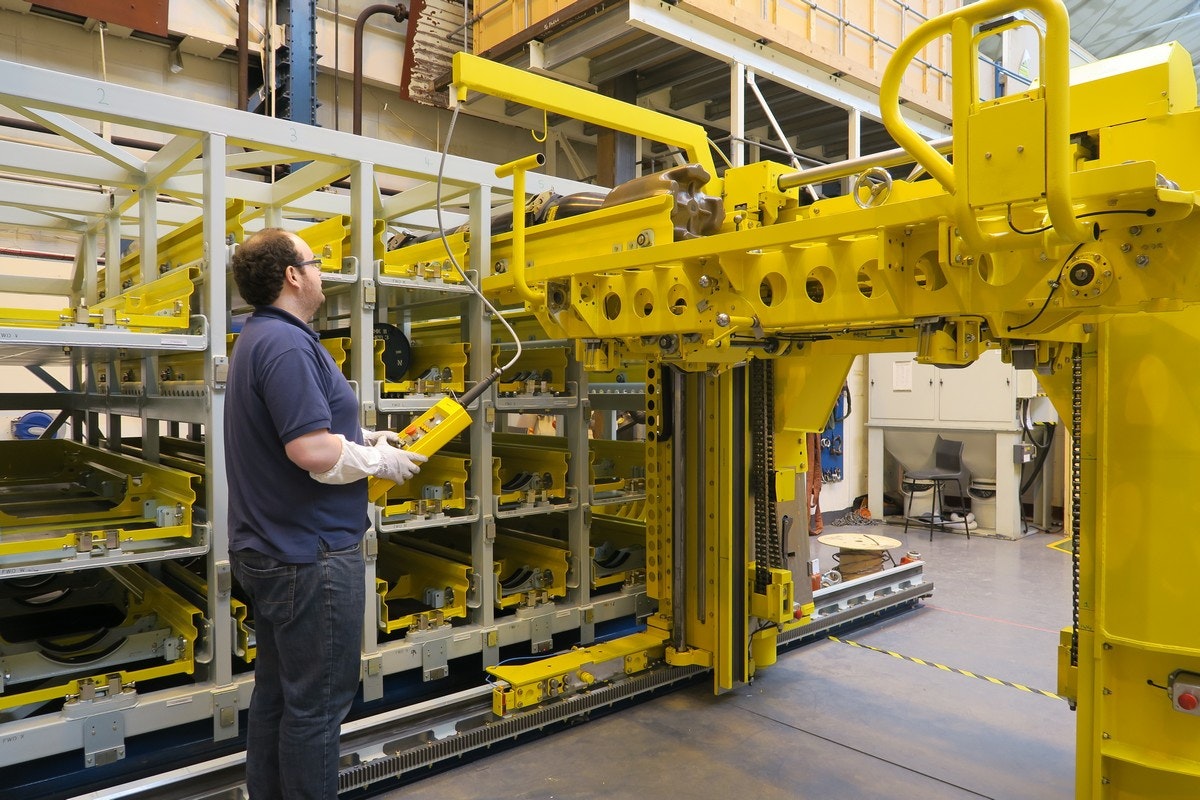
With testing culminating in an intensive three week factory acceptance period, Babcock say its engineering and production teams have successfully demonstrated the systems capability to representatives from BAE Systems, MOD, and RN – proving compatibility with both current and future weapons systems.
BAE Systems T26 Delivery Lead for Guided Weapons said:
“This is a significant step forward for the AWHS, the FAT has clearly demonstrated the performance, function and flexibility of the design; it is a credit to the Babcock project team. Following the trials there is every confidence that the system can be successfully integrated into the T26 platform and proven as a highly efficient weapon handling system. Thanks also to the MOD customer who has supported the trials notably with the provision of all the weapon types and their trolleys/containers.”



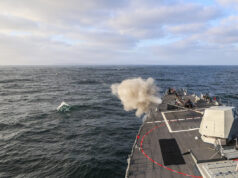
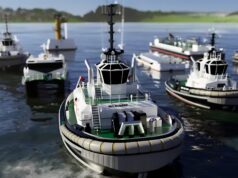
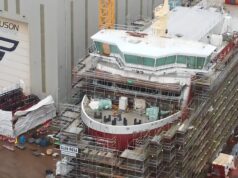
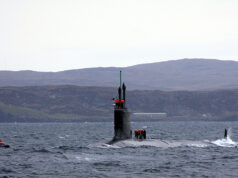
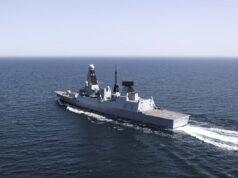

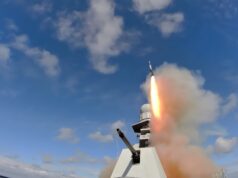
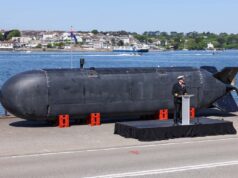
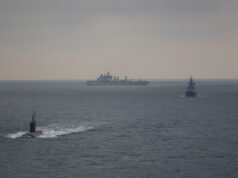

I know this system is designed to move the helo’s weapons about. But would there be a method of reloading a SeaCeptor from below decks? I appreciate that the Mk41 VLS is probably too long, but as Sea Ceptor is much shorter, could this be feasible?
I believe there is a way of doing this that would involved having a a cradle around the VLS system that can raise itself up on pistons and then bring a Missile up a single VLS that is linked to the store below deck.
All the technology is there and as our VLS’s have a protected casing the Cradle crane could sit on the outside of this and Jack itself into position when required.
TBH it shouldn’t really be needed if we install the right VLS as Seaceptor can quad pack into any of the current VLS’s we have (we choose not to quad pack).
Technically doable for relatively little cost I suspect, probably not worth it in reality.
But even replacing half of our destroyers missiles with quad packed Sea Ceptor and the rest with the long range sea viper would give them a far bigger and better load out. Or adding the fitted for but not installed mk41 would also give the RN many more options, we shouldn’t just rely on submarines for land atack considering we only have 6, and I cant understand why they don’t do it, our destroyers should have land atack ability. (Yeah yeah “money where will we find it”) we can afford many more destroyers and frigates than 19! It’s a choice.
Seems feasible, given the relative simplicity of cold launch cells. But T26 starts with 48 dedicated Sea Ceptor cells, plus the possibility of quad packing some of the Mk 41 VLS (or having additional Asters), so it would be a pretty extreme situation that would require it, given the likely presence of additional ships. In addition, moving the 100kg, 3 metre+ missiles through the ship from stores to cells might not be optimal, or best practice, or even possible, if not designed for.
Interestingly Arrowhead 140 has a crane on deck amidships adjacent to the cells, at least as shown in the recent video. So it might be more practical to re-load Sea Ceptor from the deck for at sea replenishment in this case, given its a ship with far fewer missiles to start with, although the silo location does seem to be in a good location for your proposal. Leander also has a similar crane, but its Sea Ceptor silo is forward the bridge, with the optional Mk41 VLS mid-ships, so this solution doesn’t seem as practical.
Hydraulically raise the mk41 by 3 metres,hydraulically transport the missiles horizontally from armory to beneath the mk41 vls, raise the missiles to the vertical then lower the mk 41 onto the missiles.
Not unlike the seaslug rearm used on the old dlgs.(but make it work this time)
Early Ticos and ABs had Mk41s in units of 61 rather than 64 I believe because of the 64 tubes 3 where covered by a single rectangular plate that housed a collapsible crane intended to be used for reloading at sea but it was deemed too dangerous an operation to perform at sea so was discontinued and subsequent vessels given full 64-packs of usable Mk41 tubes without 3 being allocated to crane space.
The concept of this “strike-down module is mentioned on the Wikipedia Mk41 article although I’m confused why that talks about it taking out 5 tubes rather than 3 and here’s a picture of a 61-unit Mk41 where you can see the crane hatch (3 rows up on the right side of the silo) although the crane itself is unfortunately stowed: https://www.globalsecurity.org/military/systems/ship/systems/images/mk-41-vls-pc008-053.jpg
I’m not suggesting this for T26, just adding it here for background info.
Anything is possible but why bother?
The equipment was built and There was an ambition to RAS VL Seawolf and ASTER but the Risk assessment was so bad that the idea was binned. The same will be said for Ceptor.
As to having a reload magazine below the magazine that’s just complicating matters. You would need approx 9m of hull depth to make it feasable and below the currently planned magazine is going to be other equipment that would need to be moved. Leave it as it is which is simple and effective.
The easiest way to reload is to raft up at sea to an RFA and have them crane missiles into position. We have done it with damaged Exocet in the past on T22s and they where a lot bigger and heavier.
Helo VERTREP is also out before anyone asks. Again the risk assessment for having a Helo with an under slung explosive load hovering over a vertical launch magazine full of missiles is a non starter at anytime other than war and even then its not worth the risk.
Do the type 26 frigates hold the most missiles that any British frigate or even destroyer has ever held??
Will the Australian and Canadian versions use this or something home grown? (Or is that not public knowledge yet?)
A little of topic but seeing Glass half full comment, has final decision for type 31 been announced yet?
The most recent date (quoted in May of this year) is for a winning bid decision announced in December 2019 with first steel cut in 2020.
There are a couple of words in the article that I suspect may be skimmed over but are perhaps worth calling attention to – namely “low signature”.
There is often criticism about the cost of T26 with the usual suspects of BAES, government delays and slow build highlighted as the major drivers of the cost. However, what I suspect is overlooked is also the expense associated with how the complete T26 design, including all its systems, not just hull and propulsion, is optimised for low signature. It is not just mechanical systems either, as fluid management systems meaning pipe routing/design are also similarly optimised. It is perhaps this reason more than any other why Australian and Canadian governments chose T26.
Its struck me in the past how it often seems to be assumed that a ship having a tail/VDS and helicopter for ASW is all it takes to be a sub hunter, or sometimes just a bow sonar (which may become an open invitation for a torpedo). Certainly being ultra quiet will give the T26 the best opportunity to detect ultra quiet, modern AIP submarines. But perhaps it should also not be overlooked that the hunter wants to avoid becoming the hunted, the ship wants to be as hard to detect for the sub as the later is for the former, and that ultra-quiet operation is as much about defense as it is attack in order to ultimately prevail.
I agree with all the comments on here, essentially my view is that we would be better quad packing a better VLS system
So for T45 we get rid of the aster 15 (add a booster and it joins the Aster 30 stock) and quad pack Seaceptor. This would double this ships capability overnight, for no real increase in cost (apart from missiles of course).
For T26 it could be even easier – dependant on which VLS tubes they plan to use. Even the current sea sparrow VLS can be quad packed, the RN has chosen not to. Given they are cold launch its literally just a tube, so we can add more as we see fit.
I think 2 banks of Mk41 one forward and one midship is the optimal for T26 with 24 dedicated Seacept forward as well.
but all this does cost. but again a massive uptick in capability. No real need for a crane or any such item in reality and I am sure if we really did have a need at some point we could build something quite rapidly.
There almost certainly isn’t the space midship for the deck penetration required for Mk41 there. That’s the problem with strike length VLS, they are quite disruptive in terms of ship layout. Below-decks space is a very finite resource.
For any up-arming of T26 I think the more practical option (which none the less the UK is unlikely to adopt unfortunately) would probably be to retain the midships 24 Sea Ceptor and adopt the RAN/RCN forward silo configuration of 36 x Mk41 which the design can presumably accommodate although even there I don’t know if the RAN & RCN sacrificed compartment space under that forward silo that in the RN design might contain stuff that can’t be sacrificed or relocated.
An extra 12 Mk41 up front could either duplicate the lost 24 Sea Ceptor by quad-packing 6 of the extra Mk41 and still having 30 rather than 24 Mk41 free for other stuff or, if all 12 of the extra Mk41 were quad-packed Sea Ceptor, it would increase the forward Sea Ceptor capacity from 24 to 48. It’s a more flexible configuration and as a side benefit increases commonality between the RN, RCN & RAN designs but I’m sure it is extra cost hence presumably the MoD’s reluctance to do it, or maybe there are critical compartments below the RN forward Sea Ceptor silo.
Also, why risk a Type 26 for shore bombardment with use of main gun? Is it really needed?
Yes.
The Falklands proved the need and utility of having a MR Gun on a ship. Hence the batch 3 T22 all had guns.
A T26 like a tail T23 nowadays is not just going to do ASW.
So you would put a £1Bn ship, or multiples of them, well within shore based ASM range in order to deliver NGS? I’d question doing that even with a T31.
It is a huge risk for comparatively little reward, given the other weapon options we have today that didn’t exist historically. It seems every time NGS comes up people point to history, including the Falklands and Libya. However, with the likely proliferation of shore based ASM, the Houthi’s having provided a contemporary example, we have to be damn sure our enemy doesn’t possess any, or that we can down every missile launched and also deliver an effect that makes it worth that risk.
Oh and it also seems relevant to point out that in the Falklands, HMS Glamorgan, while undertaking NGS, was hit by an Exocet, fired from an improvised shore-based launcher and only excellent ship handling resulted in a glancing hit, which unfortunately still killed 13 sailors but may well have saved the ship.
What has the price of a ship got to do with it?
Operational Capability and the ability to deliver fire onto an adversary is all that matters to the crew on board or the command in the Hole in Northwood.
NGS is a core capability for RN DD/FF and is a requirement to support the RM units ashore.
Falklands, Libya, Al Faw, all delivered (or threatened to deliver in Sierra Leonne) NGS to support troops ashore . You wont always have a friendly F35 or a coalition B52/B1 on call. At Al Faw Marlborough (Old Ships!) along with Richmond , Chatam and RAN Anzac where shooting without air cover because of a Sandstorm that grounded Tac Air. They where up a river estuary and at one point pretty much aground due to the shallow water.
From call of fire to first round out was around 2 mins on a target. A mixture of Air Burst and contact fuzing ensured anything aimed at stayed hit and was combat ineffective. Try doing that with an aircraft.
Regarding the Hoothis the most effective attacks against military units have used remote control speed boats. Again a MR gun makes a very useful addition to a ships capability to engage a target. A single 4.5 airburst will kill a target a lot easier than 120 30mm rounds.
ASMs are a threat and yes Glamorgan was hit by an Exocet. But Glamorgan had 1950s designed equipment onboard. 966 Radar , 992 Radar, Sea Cat, 40mm bofors and 7A Oerlikon 20mms. The more modern and better equipped ships (T22) avoided the missiles ( not the bombs and cannons though…we had our exocet shredded by 30mm) but we could not do the NGS work.
Getting hit is what happens in war and conflict.
Its long been said on vessels I served on that the idea is for the other guy to die for his country and not you.
You try to minimise the risk of it happening but when the push comes to shove you sometimes you have to go in all guns blazing and trust that the systems , the training and your mates deliver.
The relevance of price of the ship is that it determines how many the country gets and consequently how many it can afford to lose without severely compromising ongoing and future missions. When the UK only has 6 destroyers and 13 frigates it has very little ability to absorb loss or major damage in warships because it takes much too long to build replacements or repair.
Sure we almost invariably work with allies, so its not make-or-break on UK assets alone, but if we do choose to risk ships (and crews) we need to be clear about the effectiveness and value of the return on that risk. I don’t subscribe to the results of NGS being worth that risk, in a world of increasing ASM proliferation and particularly against a peer or near-peer adversary. Further, the political ramifications of such a loss with a domestic audience could seriously undermine broader goals and actions of a campaign.
The example of the Houthis was simply to point out that even relatively poor and dysfunctional countries have had and continue to have access to ASM weapons, particularly if they happen to have support from third party countries. Its not what they or others have achieved to date with ASM, which is relatively limited but concerning enough, but what might be achieved in future.
Wrt to your first and last paragraph sentiments. Yes we have to be prepared to take risks, sometimes huge ones, and accept losses, the Falklands demonstrated that with many examples. But we should be smart about when and how we do that.
The price of the ship is Operationally immaterial. The risk of losing a vessel or completing its task is determined by Fleet HQ and the vessel CO.
If we are talking about the impact on capability of losing a vessel because we only have 5 or 6 others that is a different issue and that is due to an under investment in resources by consecutive Govts over many years.
The RN has lost vessels from the active list for years at a time recently not because of enemy action but due to collisions ( Brilliant – a rock, Southampton- A tanker, Nottingham- A rock and there are others…). These vessels where sailing around doing what the RN does on a daily basis and what is not considered as “Risky”. In this pink and fluffy world that we now find ourselves in I am surprised sometimes that somebody is not saying the safest option is not to go to sea!
Regarding NGS I do not foresee the RN conducting NGS against peer adversaries on day 1. As in previous conflicts weeks would be spent sanitising the shore line of threats and degrading the enemies ability to fight for probably 200 miles inland. only then would anyone consider landing troops and conducting NGS. That said the T 26 is labelled as a Global combat ship. It will have modules for say RM 539 boats and space onboard for a RM detachment of say 30 troops.
Being able to land 30 Royals provide Helo support and NGS when needed in say a policing action or a raid would be a big capability increase from what FF/DDs can do now.
My use of price as a proxy for the limited number of assets has clearly confused my point. It would have been better for me to have simply said that with such a limited number of T26 (and T31 come to that), putting them at relatively high risk of ASM attack in order to undertake NGS is a very poor risk-reward trade off. Particularly because alternative weapons may achieve similar results without risking the ship.
We can’t separate availability of assets from strategy and tactics though, so total numbers are not a separate issue. If for whatever reason we only have a few ships, then we must necessarily focus on the best effective use of them and consider how to preserve them in order to have them available for future missions in the same campaign.
My core point is that we should not and would not choose to avoid risk, only that the risk must be taken into account in relation to the value of what we hope to achieve. In fact we might choose to undertake actions with higher risk of loss than NGS if a successful outcome is worth those risks.
I have to admit to not being a big fan of the idea of dedicated SeaCeptor silos- it seems so restrictive. Would the space not be better used for even a non-strike length generic VLS like Sylver 50 or the American equivalent (never got the hang of the different MK numbers)? These would be long enough (I believe) to be able to launch ASMs like Harpoon and the NMS, and still wide enough to quad pack SeaCeptor. I can’t imagine that the SeaCeptor silos are shallower than a Sylver 50?
Otherwise, I agree with everything you put above.
I’d turn your position around and ask “Under what circumstances would we not want 48 Sea Ceptor?” Today and future environments I suggest we always would. So if that’s the case then why use more expensive hot launch cells to quad pack Sea Ceptor, versus lower cost cold launch cells, which have more flexibility for placement/location in a ship? Save the hot launch cells for missiles that need it.
Regarding size, imagine away 🙂 Sea Ceptor is ~3.5m long including canister. The Land Ceptor launch systems show the cell system doesn’t need to be much longer than this. Sylver 50 as fitted on T45 takes 5.0m long missiles, so the actual cell module will be significantly taller, Mk41 tactical length VLS module, the closest proxy to Sylver 50, is 6.7m tall and Mk41 strike length VLS module as fitted on T26 is 7.6m tall. So vertical space may be significantly compromised if quad packing CAMM into hot launch systems instead of dedicated cold/soft launch cells. The new 3-cell ExLS is probably the shortest, most space efficient Mk41 compatible VLS system as it seems to have been designed for CAMM and cold launch … but then it wouldn’t support alternative hot launch missiles.
Fair points, well made! Gives me some food for thought, thank you 🙂
You cannot VL harpoon. Thats why even USN Ticos and Burkes have the same sort of launchers that the RN has.
Thanks, I didn’t realise that! It was just an assumption, based on how long it had been around and how popular VLS is. I guess I should not make so many assumptions….
Its the reason the missile or ‘armoury’ battleship concept never took off with the Kirov class the only thing coming close due to low hull numbers in the USSR. Putting extreme amounts of missiles on one ship is akin to putting all your eggs in one basket.
That is a argument to have more small frigates, for RN say 10 Type 31. And maybe more destroyers, but some armed with either Mk41 or Sylver.
The KIROV was big because it had single decker bus sized SSN 19 “Shipwreck” missiles taking up most of the Fwd area.
I wonder if Sea Ceptor quad packed in Sylver VLS cells would be the best use of those cells? Instead of the usual proposed solution of adding Mk41 VLS to T45 or quad packing in Sylver, it seems like it might be much more economic and easier to integrate additional cold launch Sea Ceptor cells into T45 and retain the Sylver cells for missiles that need hot launch. So in the case of T45 that would be more Aster 30 and perhaps Aster BMD, keeping T45 as a dedicated AAW destroyer.
If you add strike length Mk41 mid-ships to T26 then I think you’re going to have to give up some of the mission module space. That doesn’t make sense for the current ASW T26 variant but might for a future T26 AAW focused replacement of T45.
Instead replace main gun with a CIWS type of weapon further forward to the bow, creating space for a further row of Sae Ceptor.
No.
A CIWS would get battered by heavy seas and be unservicable 90% of the time.
Ok, I get your point. So really, the bow on Type 26 frigate needs to be lengthened in order to fit more rows of VLS cells?
I agree on the use of the T45 FFBNW Mk41 space for dedicated Sea Ceptor launchers. T45 are so few in numbers that with our carriers, supporting allies’ carrier groups etc I can’t see our T45s spending much time in anything other than dedicated AAW roles so it makes sense to make it the best AAW escort that it can be. We all know how tight money is so using that space for Sea Ceptor seems a reasonably affordable way to significantly enhance T45’s AAW capability.
I do still worry about the dedicated Sea Ceptor launchers though. I realise T23 mushroom farms don’t count because those were an expedient 1-for-1 upgrade but looking at T26 renders of the forward silos and comparing the deck space taken up by the 24 dedicated Sea Ceptors launchers vs the Mk41s that, if one were crazy enough to quad-pack them all would be a 96 Sea Ceptor silo, the dedicated silo actually seems less deck-space-efficient than quad-packing Mk41 which doesn’t seem right given the cold-launch are designed for purpose with no exhaust gas vents whereas the Mk41s carry a lot of extra baggage.
I worry that we’re not fully exploiting the simplicity of the cold launch concept if we’re packing them too sparsely and inefficiently using the dedicated silos. For instance if that T45 Mk41 space (for 12 Mk41 tubes?) couldn’t host 48 dedicated Sea Ceptor launchers, i.e. what could have been hosted by quad-packing 12 Mk41s, then there’s something sub-optimal in the design of the dedicated Sea Ceptor silos that we’re using.
I suspect its down to cost trade-offs, but if you want to quad pack Sea Ceptor without using a full Mk41 tactical or strike length solution then the ExLS was designed for this purpose. You may recall it was shown on some of the early candidates for the T31 program, BMT’s Venator-110 in particular showed the 3-cell ExLS as an option.
Yeah. I do remember the use of 3-cell ExLS on some of the Venator-110 configuration options that BMT showed.
By the way, just to be clear in case I’m not, for T45 I’m not suggesting quad-packing Mk41. I’m just saying that if our dedicated designed-for-purpose Sea Ceptor launchers can’t make at least as efficient use of deck space as quad-packing Mk41 then we’ve done a bad design job on our custom launchers and we’re squandering (at least partially) one of the benefits that should come with Sea Ceptor i.e. simpler launch system means no exhaust gas venting which should mean compact and cheap launchers. As you say, I’m sure cost is an issue so maybe we have got the cheap bit but with good design I don’t see why we can’t get the compact bit as well without increasing cost significantly.
I didn’t phrase my response well as I had understood that you were just after increased packing density and not necessarily quad packing. So apologies if it came over otherwise.
Regarding tighter packing, and in this case I’ll also include ExLS as an example, there may be other factors than just cost.
In a quad-pack only one missile can fire from a quad pack at a time and that probably goes for any tight packing of missiles, in order not to interfere with each other. Spreading them out may enable more launches in a shorter period against multiple simultaneous attacking threats. There won’t be many seconds to react and launch missiles against supersonic sea skimming ASMs.
The T23 mushroom farms have angled launchers so if the rocket fails to ignite the missile falls back into the sea, tighter packing may undermine this. I don’t know if T26 also does this.
Replenishment at sea may be practical for single missiles, but may not be if it requires multiple missiles in a container to all be replaced at the same time. Its not clear for example if ExLS allows individual missile replacement or requires the entire quad pack to be removed and replaced.
Just some thoughts.
Would not a CIWS type of gun be more appropriate for a ASW frigate, instead of a main gun? If so, positioned weapon further forward to the bow, thereby creating space for further row of VLS cells including Sea Ceptor.
“… why risk a Type 26 for shore bombardment with use of main gun?”
What would be the alternative?
“Would not a CIWS type of gun be more appropriate for a ASW frigate, instead of a main gun?”
The T26 is suppose to already have 2 Phalanx CIWS weapons mounted. The Mk45 Gun system is designed for use against surface warships, anti-aircraft and shore bombardment. Why neuter the T26 by removing the main gun?
Ok, I get your point, thanks for your argument!
A number of alternatives, depending on what is trying to be achieved. In such a scenario it seems unlikely we are having an isolated ship launch NGS, so an attack might include assets from multiple ships. Options include helicopter and/or fixed wing launched bombs, missiles and cruise missiles. Ship launched cruise missiles. Weapons like Martlet, Sea Venom, Brimstone, SPEAR 3, up to heavier weapons such as JSM and beyond.
I don’t know what Meirion had in mind, and it may not be practical to move CIWS/gun systems further froward, but the Mk110 57mm would meet most requirements and be less expensive than the Mk45 5″ that’s costing >$60M per gun system on the T26. MK110 is easily adequate for ship engagements with its high rate of fire and deep magazines, especially FIAC, unless we see ourselves exchanging gunfire with other frigates or larger warships, which frankly seems absurd. I’ve already detailed NGS vulnerability to shore based ASM elsewhere.
Quad packing SC on a T45 does not give you the system. You need somewhere to put the SC data link domes and equipment cabinets( Though the cabinets are household fridge sized so not an issue) so as to give 360 degree transmission coverage. Whilst small and lightweight they would also need to be positioned so as to avoid mutual interference issues on the transmitting frequency’s of other sensors.
From the comments there are several questions/comments.
About the announcement of the T31 that if I understand correctly is meant to be at the end of this year. I am concerned about this as there is meant to be a strategic review in autumn.
T45 and the Mk41 VLS, I totally agree that the T 45 should be equipped with the Mk41 and they should be armed with cruise missiles and the Aster BMD this would give the T45 a tactical as well as a strategic punch. The idea of replacing the Aster 15 with quad packed Sea Ceptor is a good one and I do not sea a reason why it should not be done, by replacing 12 of the Aster tubes with quad pack gives a anti air capability of 36 Aster 30 and 48 Sea Ceptors plus 8 Aster BMD in the Mk41s. A true Anti Air destroyer.
As for the T26, Yes it takes more than a tail to make an anti submarine frigate, and as far as I am aware the T26 will be the most heavily armed frigate produced by the Royal Navy. I don’t know if I am fully up to date with this vessel as there is still some confusion on her weapons fit, but if I understand correctly she is to be armed with 48 Sea Ceptors and 24 Mk41s. However in the original design concept there was provision for the mid ships multi mission bay to be able to take further Mk41s if need be. If that capability has been hard wired in then it will become a very potent carrier escort. However here is the problem if the T26 is to be the carrier escort then why is she designed as an Anti sub platform, a carrier group in combat will not sneak around at five knots listening for subs but will go charging around at 20 knots+. One of the reasons that the US Navy are not very good at Anti Submarine work, they don’t have designated Anti Sub platforms but Carrier escorts with Anti Sub capability. They literally have just bolted on a tail to there Arliegh Burke class and rely on there SSNs for the designated Anti Sub escort. I suspect for the QE carrier group we will rely on an SSN for anti sub work as the other issue is that the T26 does not have the speed to go ahead of the carrier group slow to a crawl listen, sanitise the area that the carrier will pass through and then catch up again, then do it all over again speed and drift speed and drift. You can’t go around at 20 knots with your tail in the water.
One thing concerns me and it applies to the carriers as well as the new T26s the automated magazine handling. It is all well and good automating as much as possible, but it should also be designed to be man handled if need be. The T 26 is a ship of war and in times of war people will shoot at her and she will get damaged, there will be electrical failures. We all know what Heathrow baggage handling is like and that is an automated computer control handling system. What bloomin good is a state of the art automatic computer control magazine if the system does not work and people cannot get to the reloads. Have these systems been tested under shock, have they been tested where system is down and you need manual loading. If not why not? To me if the picture is anything to go by looks like the handling system can be put out action by a loose nut getting into the running rail.
You have hit it on the nail Ron!
This is what I have argued in a past post, a Type 26 frigate/s would need to sail ahead of the main fleet to sanitise areas that the fleet will sail through.
Type 45’s and Type 31’s should be the real close
escorts.
I’m intrigued as to why you think it’s computerised. The controls look like what you get for a standard xy crane. Computerised I’d expect a different HMI.
As for shock, a quick google search on a stingray shows its less than 300kg. It fairly heavy duty if it’s not shock rated and it does talk about shock in the text.
Jack, the reason that I think it is computerised is that I have seen quite often written that the principles for the QE is the same as what companies such as Amazon use and that the T26 system is based on that. They are fully automated they know where xyz is go and retrieve. I will show my ignorance in that I don’t know what you mean with HMI.
I understand that a stingray torp is about 300 kg, but when I am speaking about shock is when a ship is constantly slamming due to weather or when receiving a hit. Things work loose. During WW2 for example it was not unknown for a main turret to jump of its barrings, those things weigh up to 2,000 tons. Or a main gun to jump its cradle again up to 100 tons per barrel. What I do not see is any good old fashioned block and tackle as a back up. Old fashioned yes but you can shift anything with it.
The handling system will have manual back up. On a T23 system it is a case of insert handles and turn by hand and attach chains on the drive pulleys and move by hand.
Secondary Ammo resupply is regularly practised on board. For Close range ammo ( Bullets) and MR Gun Shells, it still is block and tackle, miller flaps and cruets…nothing much has changed since WW1 or earlier for moving ammo from a deep mag to a gun when the hoist is out of action.
The whole stowage rack would be shock mounted top and bottom.
I won’t repeat everything I’ve already posted in response to other comments but in summary additional Sea Ceptor cells for T45 to increase missile load out is much more practical and affordable than adding MK41 VLS. Keeping T45 as a a dedicated AAW destroyer. The only missile the UK uses that might be qualified for MK41 in a T45 combat system is Tomahawk, and despite plans for Block V, it is an old platform that is neither stealthy nor supersonic and as such rather questionable for future potential use in a Tier 1 conflict, which has to be the bar we have to clear. Far better to focus on the MBDA UK/France FC/ASW joint program for future MK41 T26 use, perhaps with JSM as a lower spec weapon.
If T26 ever has Mk41 mid-ships then it would be more likely as the AAW replacement for T45 after the 8 ASW variants are built. As an AAW destroyer variant, the T26 would not be conducting ASW.
Too much is read into the 26+ knots T26 quoted speed. I’ll be surprised if it isn’t capable of >30 knots in a sprint, assuming we’d even want to operate it that way. Its also worth recognizing that unlike US carrier groups, the QEC and POWC don’t require high wind speed over the deck (and hence ship speed) to launch aircraft – another perhaps not so obvious benefit and advantage for the F35B and the launch ramp that seems to get overlooked when folks bang on about CATOBAR.
I agree with the observation regrading the USN and ABs. The current US FFG(X) frigate program seems a perfect match for T26, from a specification and need perspective. They are clearly emphasising ASW, but budget and existing hull in the water requirements, however tenuous in the case of the latter, seem to exclude it. One would think they’ve had enough embarrassing periscope shots of carriers. Clearly it wasn’t just ROE that led to these shots given the subsequent long term lease of the Swedish AIP sub.
“As an AAW destroyer variant, the T26 would not be conducting ASW”
Every vessel in the RN practises ALL types of warfare. T45 do ASW. T23 do HVU( High Value Unit) AAW escort work. I have even done ASW on an LPD and we did not have a sonar. We did have outstanding data links and a big flight deck though so we drove everyone else around the sea and controlled the Helos.
I should have qualified my comment better wrt primary role. Indeed you can ask any vessel to do ASW work, particularly with the advent of ISO based ASW mission modules from the likes of Thales and future USV/UUV capabilities. Or as you point out a T45 pinging the hell out of the ocean and deploying a Wildcat with a torpedo in the event it finds something. The downside is that its active sonar will have advertised exactly where it is, if that wasn’t already known. I suspect torpedoes are only going to be getting much smarter in future, so this tactic may not be the wisest.
But to clarify my original comment, if there is a future T26 in an AAW configuration performing its primary role of carrier escort and group air defence then it wouldn’t be desirable to have it get too far away from the carrier doing ASW work, unless very certain that there was no air threat. Away from the primary AAW role it might perform in many different roles. Certainly a T26 AAW variant, assuming it retains its low signature characteristics and with or without ASW kit, will be a far more able ASW asset than T45.
The S2087 tail on a T23 and a T26 is active. Yes its LF but its still active.
A T26 hull form that is used as a basis for a AAW unit is attractive. I doubt however that the MOD will stump up the cash for a ASW/AAW variant that retains the ASW nice to haves. Double raft mounting of equipment amongst other quietening techniques, is to expensive a proposition.
Passive-only operation capable too though. From very low, through medium to ultra-high frequencies. Including mammal monitoring, to seek out those pesky Russian Beluga whales no doubt.
Ah the joys of Air weapon handling…
T42- manual handling using portable rails and Didsbury hand wound hoist- Manpower at least 6
T22- manual handling using portable rails and Didsbury hand wound hoist- Manpower at least 6
T23- Air powered handling system manpower 3-4
T26- Powered handling system Manpower probably 2 but you will need 4.
A T23 system is powered but it had manual back ups if it lost the air to the drive motors ( Air powered because you want to keep electrics to a minimum in a weapon mag). To pull the torpedo , DC or Skua (when we still had it) out of the rack you attach the handler to the rack trolley containing the weapon and pull it out. You then lift and clamp the weapon in the handler and re-stow the trolley. You can then lower the weapon down into the Torpedo Handling trolley.
At this point for a SR or DC you can fit all the Flight in Air Material ( Parachute Drogue, Arming wires, nose cap and suspension system) then take it out to the HELO. Problem is that at this point you still need 4 people to prep and move the weapon in a sea way. A 300kg SR + FIAM + Trolley is a lot of weight (550 Kg) to move in roughers. Once given to the Flight for loading they can use the Helo Handling rail system to take the weapon out to the helo under mechanical control.
For info the Fleet Standard Time for a good air weapons handling team to deliver 2 Stingrays ready for flight is 40mins. I used to average , with my teams (8 Ships crew and 2 crew from the flight) 2 stingrays, 2 DCs and a couple of sea skua in around 30 mins.
Gunbuster, Thanks for that, in fact can I have your permission to keep that info. The reason is that I am writing my PhD thesis in Naval History, (tactics and strategy) mostly Mahan stuff. So along the way I collect information, store it as I never know when it might prove useful.
Its funny that you mention the T42 as one of my friends was the naval architect for the T42 hull.
Now I know who to blame for the carp accom we had during my time on the Brum!
🙂